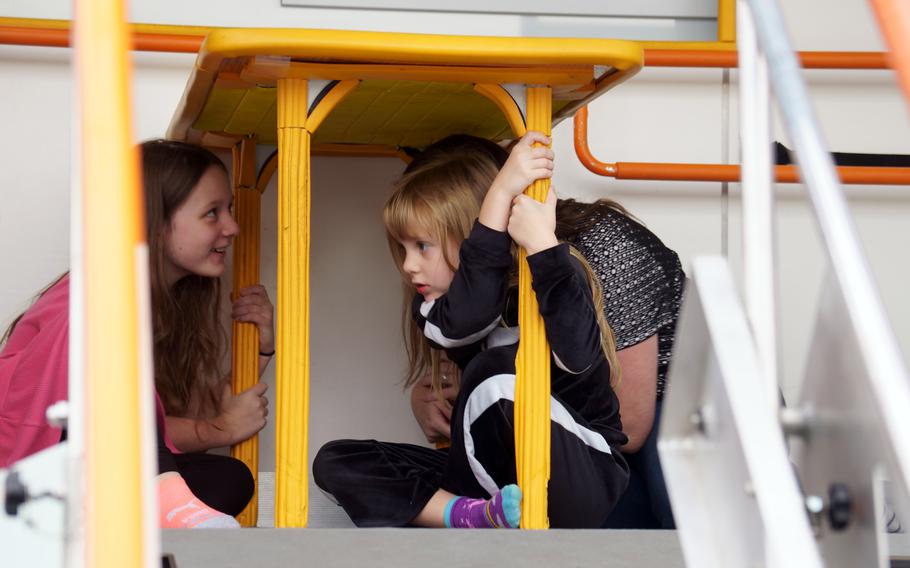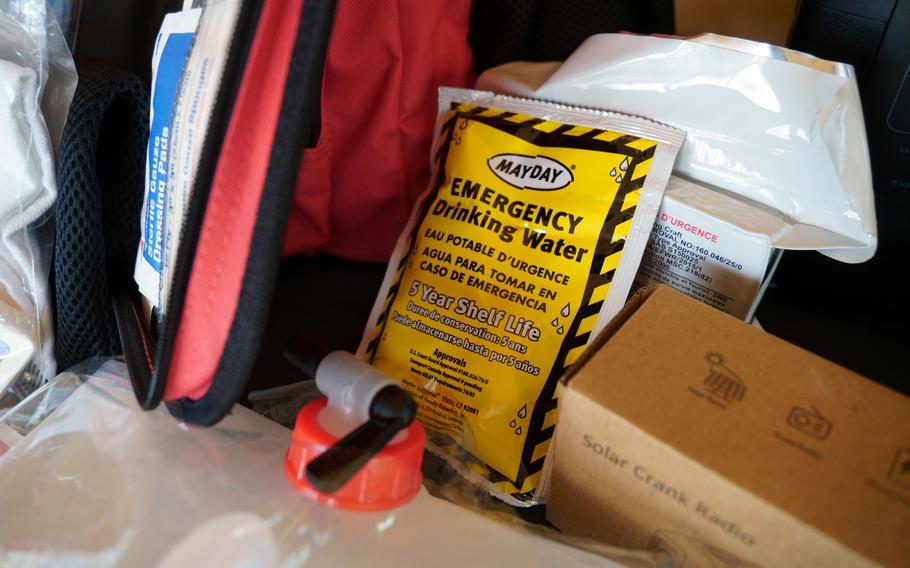YOKOTA AIR BASE, Japan — The “room” attached to the back of a Tokyo Fire Department truck began to shake violently as the occupants crouched beneath a flimsy table at this airlift hub in western Tokyo.
Set to recreate the experience of a magnitude 7 earthquake, the simulator shook the entire truck for about 30 seconds.
Once the shaking stopped, the volunteers experiencing the simulated temblor emerged from beneath the table after sensing it was safe to do so.
The fire department’s quake simulator was available for the Great ShakeOut, an event sponsored by the American Red Cross outside the Yokota Community Center on Wednesday afternoon, along with a smoke escape simulator and information on preparing for earthquakes in Japan.
On Thursday, the Red Cross also put on a 90-minute class on earthquake prep at the adjacent Military Family and Readiness Center.
“It’s not a matter of if the next big earthquake will happen, it’s a matter of when, and we need to make sure that we’re prepared for when it does happen,” David Garrison, the Red Cross regional program manager at Yokota, told Stars and Stripes at Wednesday’s event.
Japan experiences upwards of 1,500 earthquakes each year, according to the University of Tokyo website. Most of them go unnoticed but one or two may result in property damage, injuries or loss of life.
Most recently, the Japan Meteorological Agency for the first time issued a megaquake warning in August after magnitude 7.1 temblor struck offshore of Miyazaki prefecture on Kyushu, the southernmost of Japan’s four main islands. It damaged three buildings and injured 16 people.
Epic, killer quakes are engrained in Japanese history.
On Jan. 1, a magnitude 7.5 earthquake shook the Noto Peninsula on western Honshu, the largest main island, collapsing buildings, buckling roads and causing more than 200 deaths. The region suffered heavy rains and mudslides in September and its people are still recovering from those events.
In 2011, Japan experienced a massive magnitude 9 magnitude quake on northern Honshu that also produced a tsunami, killing nearly 20,000 people and forcing more than 470,000 people to evacuate. That disaster prompted the U.S. military to evacuate some nonessential personnel and launch Operation Tomodachi, in which U.S. forces assisted with disaster-relief efforts.

Military spouse Kristen Lindholm and her kids experience the Tokyo Fire Department's earthquake simulator during the Great ShakeOut event at Yokota Air Base, Japan, Oct. 16, 2024. (Akifumi Ishikawa/Stars and Stripes)
The lessons are not lost on Kristen Lindholm, a military spouse who brought her two young daughters to the Great ShakeOut.
“I think I’m pretty well prepared, but I think for my kids it was helpful,” she said at the event. “It was nice to feel what a simulated earthquake feels like. We’ve felt little ones, of course, but to feel what a bigger one would feel like is pretty scary.”
In the past, emergency management experts recommended having three days of supplies in the event of a natural disaster.
But the Red Cross at Yokota recommends having at least 10 days of supplies on hand and splitting them between several locations in case one or more areas are inaccessible, Garrison said.
“I want as many people to be prepared as possible, and to make sure nobody has all their eggs in one basket,” he said.
A communication plan is another aspect of earthquake preparedness stressed by the Red Cross.
“It’s going to be really, really, hard to communicate with people locally,” he said. “It might be easier actually to text or call people in another country, but either way, you need to have some kind of way to communicate with your family to let them know you’re OK.”

Emergency supplies are displayed at the Great ShakeOut, an earthquake preparedness event sponsored by the American Red Cross at Yokota Air Base, Japan, Oct. 16, 2024. (Akifumi Ishikawa/Stars and Stripes)